Laser Direct Writing of Dual-Scale 3D Structures for Cell Repelling at High Cellular Density
Abstract
:1. Introduction
2. Results and Discussion
2.1. Structures Fabrication and Characterization
2.1.1. Structures Fabrication by Laser Direct Writing via Two-Photon Polymerization
2.1.2. Structures 2D Morphological Characterization by Optical Microscopy
2.1.3. Structures 2D Morphological Characterization by Scanning Electron Microscopy
2.1.4. Structures 3D Morphological Characterization by Atomic Force Microscopy
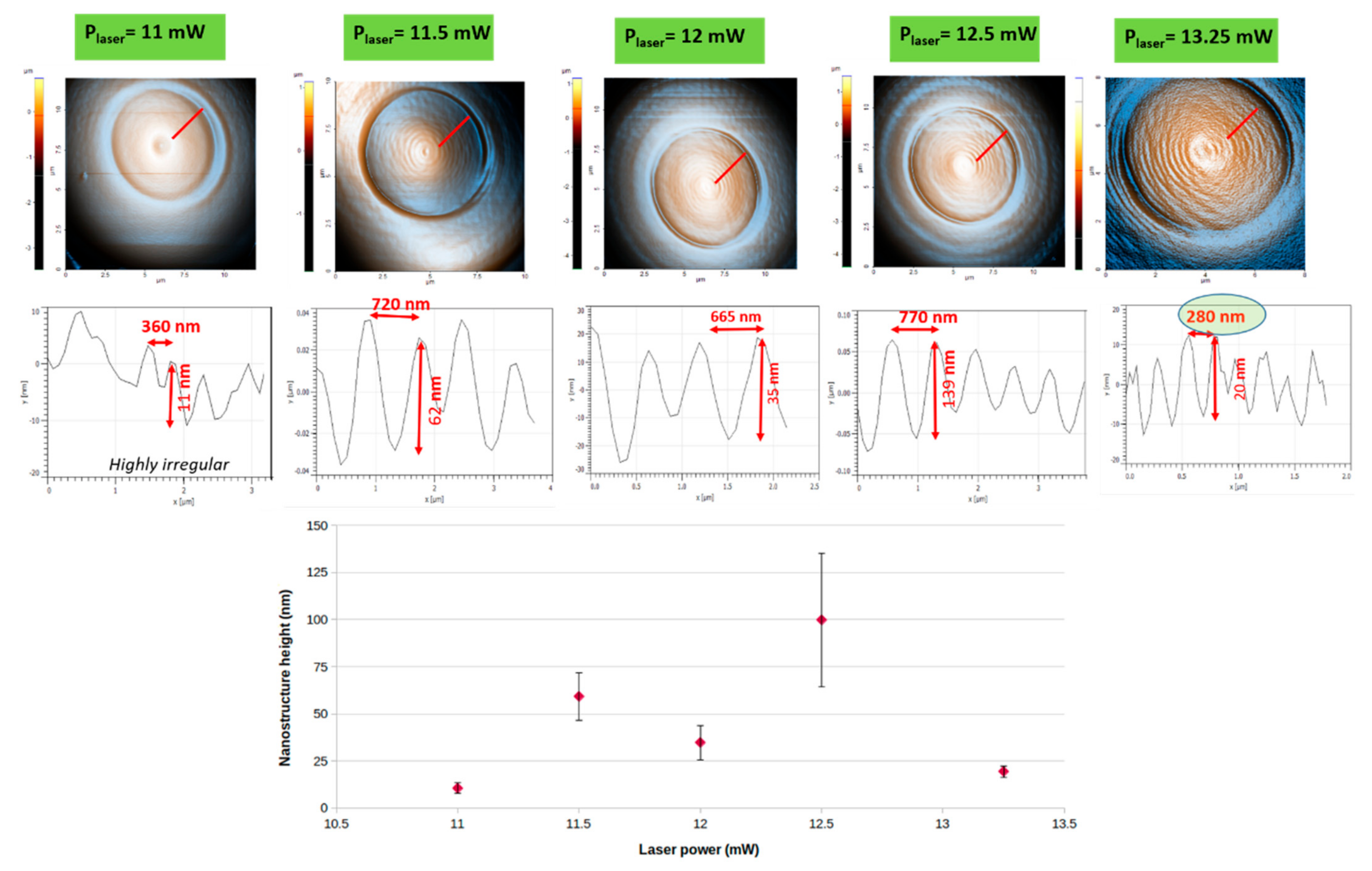

2.1.5. Surface Geometry of NMP Structure: 2D and 3D Characterizations and Theoretical Fitting
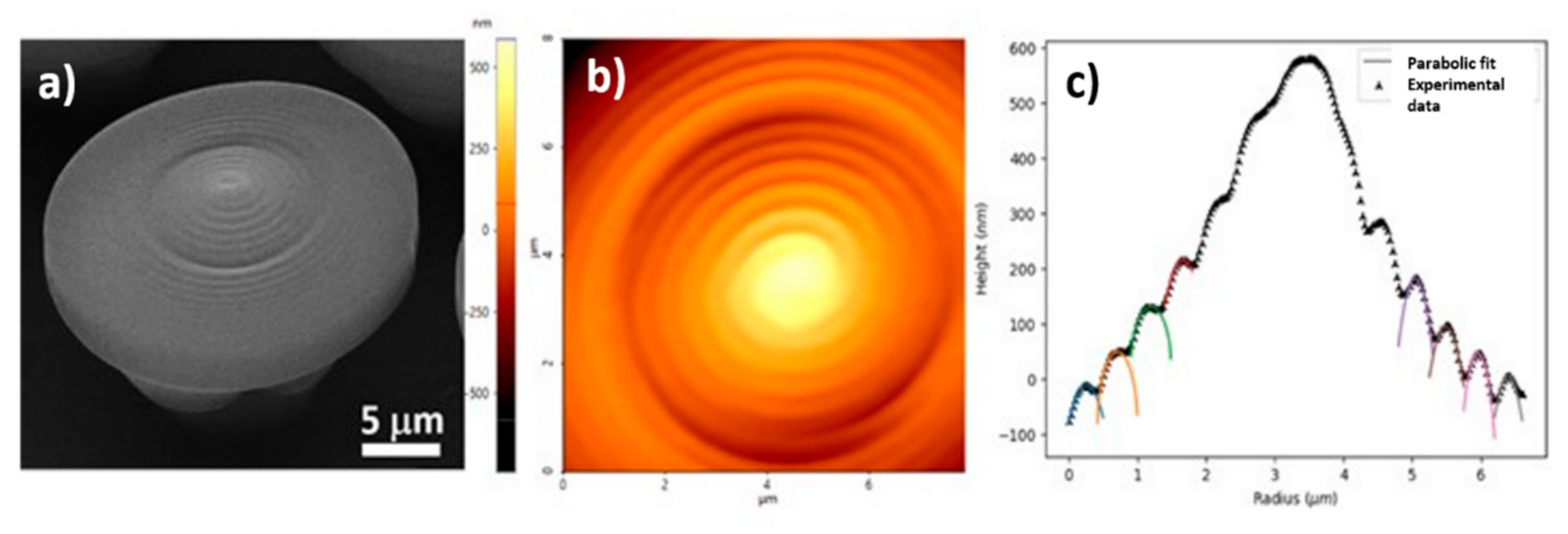
2.2. In Vitro Studies
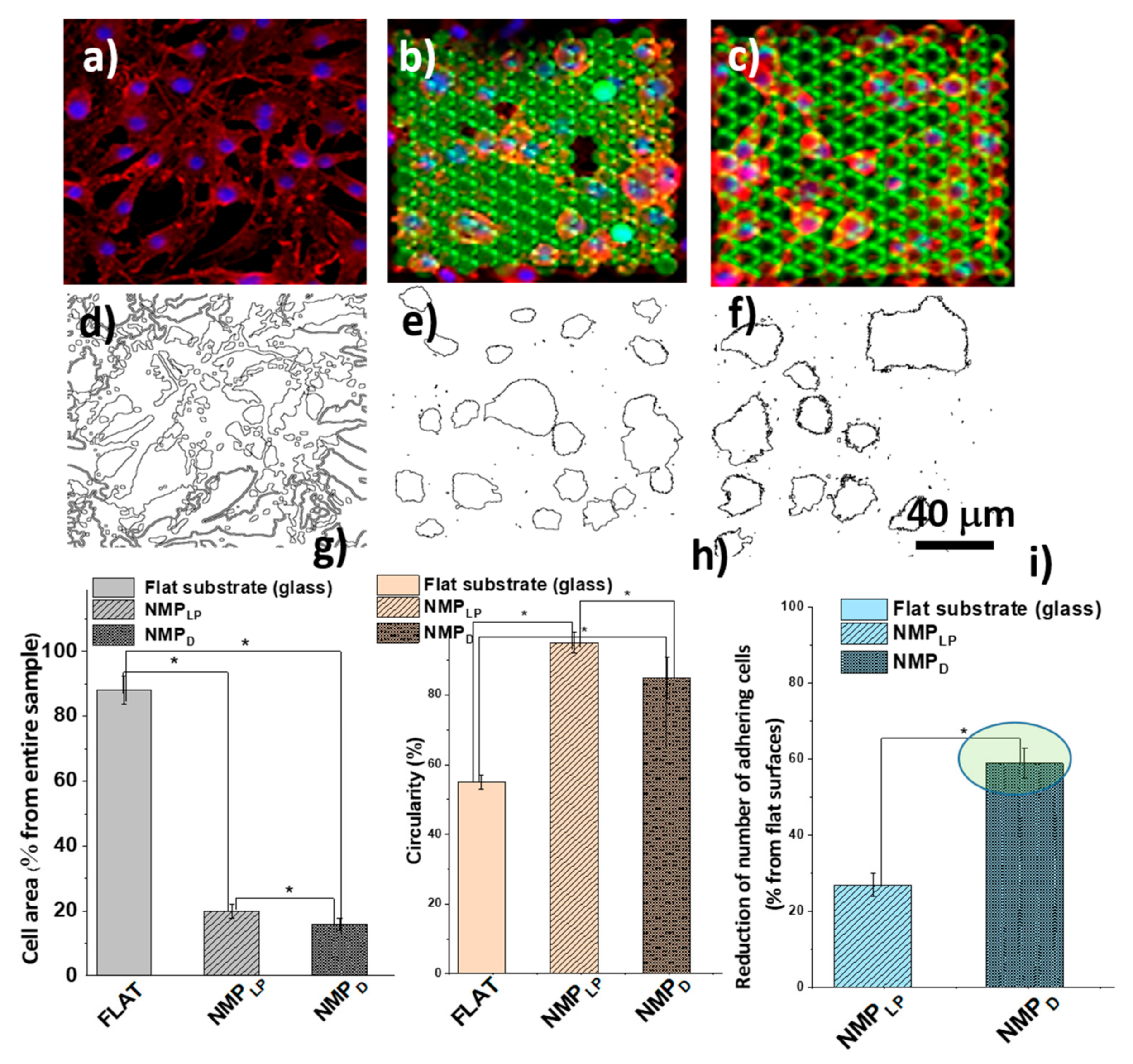
3. Conclusions
4. Materials and Methods
4.1. Structure Fabrication
4.2. Structure Characterization
4.2.1. SEM
4.2.2. AFM
4.2.3. Cell Culture
4.2.4. Sample Preparation and Cells Seeding
4.2.5. Immunocytochemistry
4.2.6. Image Acquisition and Processing
Author Contributions
Funding
Institutional Review Board Statement
Informed Consent Statement
Acknowledgments
Conflicts of Interest
References
- Zhenyua, L.; Minghui, H. Femtosecond Laser Precision Engineering: From Micron, Submicron, to Nanoscale. Ultrafast Sci. 2021, 2021, 9783514. [Google Scholar] [CrossRef]
- Zafar, M.S.; Fareed, M.A.; Riaz, S.; Latif, M.; Habib, S.R.; Khurshid, Z. Customized Therapeutic Surface Coatings for Dental Implants. Coatings 2020, 10, 568. [Google Scholar] [CrossRef]
- Kunrath, M.F.; Hubler, R.; Shinkai, R.S.A.; Teixeira, E.R. Application of TiO2 Nanotubes as a Drug Delivery System for Biomedical Implants: A Critical Overview. ChemistrySelect 2018, 3, 11180–11189. [Google Scholar] [CrossRef]
- Hu, C.; Ashok, D.; Nisbet, D.R.; Gautam, V. Bioinspired surface modification of orthopedic implants for bone tissue engineering. Biomaterials 2019, 219, 119366. [Google Scholar] [CrossRef] [PubMed]
- Liu, J.; Mohd, R.N.B.; Wong, L.M.; Wang, S. Surface Treatment and Bioinspired Coating for 3D-Printed Implants. Front. Chem. 2021, 9, 768007. [Google Scholar] [CrossRef]
- Guang, Z.; Gunching, W.; Jiao, J.L. Advances in implant surface modifications to improve osseointegration. Mater. Adv. 2021, 2, 6901–6927. [Google Scholar] [CrossRef]
- Robotti, F.; Bottan, S.; Fraschetti, F.; Mallone, A.; Pellegrini, G.; Lindenblatt, N.; Starck, C.; Falk, V.; Poulikakos, D.; Ferrari, A. A micron-scale surface topography design reducing cell adhesion to implanted materials. Sci. Rep. 2018, 8, 10887. [Google Scholar] [CrossRef]
- Campuzano, S.; Pedrero, M.; Gamella, M.; Serafín, V.; Yáñez-Sedeño, P.; Pingarrón, J.M. Beyond Sensitive and Selective Electrochemical Biosensors: Towards Continuous, Real-Time, Antibiofouling and Calibration-Free Devices. Sensors 2020, 20, 3376. [Google Scholar] [CrossRef]
- Cao, L.; Chang, M.; Lee, C.-Y.; Castner, D.G.; Sukavaneshvar, S.; Ratner, B.D.; Horbett, T.A. Plasma-deposited tetraglyme surfaces greatly reduce total blood protein adsorption, contact activation, platelet adhesion, platelet procoagulant activity, and in vitro thrombus deposition. J. Biomed. Mater. Res. 2017, 81A, 827–837. [Google Scholar] [CrossRef]
- Mhaske, A.R.; Shetty, P.C.; Bhat, N.S.; Ramachandra, C.S.; Laxmikanth, S.M.; Nagarahalli, K.; Tekale, P.D. Antiadherent and antibacterial properties of stainless steel and NiTi orthodontic wires coated with silver against Lactobacillus acidophilus—An in vitro study. Prog. Orthod. 2015, 16, 40. [Google Scholar] [CrossRef] [Green Version]
- Richards, C.; Slaimi, A.; O’Connor, N.E.; Barrett, A.; Kwiatkowska, S.; Regan, F. Bio-inspired Surface Texture Modification as a Viable Feature of Future Aquatic Antifouling Strategies: A Review. Int. J. Mol. Sci. 2020, 21, 5063. [Google Scholar] [CrossRef]
- Rahmawan, Y.; Moon, M.W.; Kyung-Suk, K.; Kwang-Ryeol, L.; Kahp-Yang, S. Wrinkled, Dual-scale structures of diamond-like carbon (DLC) for superhydrophobicity. Langmuir 2010, 26, 484–491. [Google Scholar] [CrossRef]
- Rahmawan, Y.; Jang, K.J.; Moon, M.W.; Lee, K.R.; Suh, K.Y. Anti-biofouling coating by wrinkled, dual-roughness structures of diamond like carbon (DLC). Biochip. J. 2009, 3, 143–150. [Google Scholar]
- Mota, C.; Puppi, D.; Dinucci, D.; Errico, C.; Bártolo, P.; Chiellini, F. Dual-Scale Polymeric Constructs as Scaffolds for Tissue Engineering. Materials 2011, 4, 527–542. [Google Scholar] [CrossRef]
- Lin, P.C.; Yang, S. Mechanically switchable wetting on wrinkled elastomers with dual scale roughness. Soft Matter 2009, 5, 1011–1018. [Google Scholar] [CrossRef]
- Hao, Z.; Colombier, J.-P.; Witte, S. Laser-induced periodic surface structures: Arbitrary angles of incidence and polarization states. Phys. Rev. B 2020, 101, 245430. [Google Scholar] [CrossRef]
- Shukla, P.; Waugh, D.G.; Lawrence, J.; Vilar, R. Laser surface structuring of ceramics, metals and polymers for biomedical applications: A review. In Laser Surface Modification of Biomaterials; Vilar, R., Ed.; Woodhead Publishing: Sawston, UK, 2016; pp. 281–299. ISBN 9780081008836. [Google Scholar] [CrossRef]
- Cunha, A.; Oliveira, V.; Vilar, R. Ultrafast laser surface texturing of titanium alloys. In Laser Surface Modification of Biomaterials; Vilar, R., Ed.; Woodhead Publishing: Sawston, UK, 2016; pp. 301–322. ISBN 9780081008836. [Google Scholar] [CrossRef]
- Yi, L.; Brelet, Y.; He, Z.; Yu, L.; Forestier, B.; Deng, Y.; Jiang, H.; Houard, A. Laser-induced periodic annular surface structures on fused silica surface. Appl. Phys. Lett. 2013, 102, 251103. [Google Scholar] [CrossRef] [Green Version]
- Bonse, J.; Krüger, J.; Höhm, S.; Rosenfeld, A. Femtosecond laser-induced periodic surface structures. J. Laser Appl. 2012, 24, 042006. [Google Scholar] [CrossRef]
- He, X.; Datta, A.; Nam, W.; Nam, W.; Traverso, L.M.; Xu, X. Sub-Diffraction Limited Writing based on Laser Induced Periodic Surface Structures (LIPSS). Sci. Rep. 2016, 6, 35035. [Google Scholar] [CrossRef]
- Zhang, Y.; Jiang, Q.; Cao, K.; Chen, T.; Cheng, K.; Zhang, S.; Feng, D.; Jia, T.; Sun, Q.J. Extremely regular periodic surface structures in a large area efficiently induced on silicon by temporally shaped femtosecond laser. Photon. Res. 2021, 9, 839–847. [Google Scholar] [CrossRef]
- Parellada-Monreal, L.; Castro-Hurtado, I.; Martínez-Calderón, M.; Presmanes, L.; Mandayo, G.G. Laser-induced periodic surface structures on ZnO thin film for high response NO2 detection. Appl. Surf. Sci. 2019, 476, 569–575. [Google Scholar] [CrossRef] [Green Version]
- Kumar, D.; Liedl, G.; Gururaja, S. Formation of sub-wavelength laser induced periodic surface structure and wettability transformation of CFRP laminates using ultra-fast laser. Mater. Lett. 2020, 276, 128282. [Google Scholar] [CrossRef]
- Böker, K.O.; Kleinwort, F.; Klein-Wiele, J.-H.; Simon, P.; Jäckle, K.; Taheri, S.; Lehmann, W.; Schilling, A.F. Laser Ablated Periodic Nanostructures on Titanium and Steel Implants Influence Adhesion and Osteogenic Differentiation of Mesenchymal Stem Cells. Materials 2020, 13, 3526. [Google Scholar] [CrossRef] [PubMed]
- Martinez-Calderon, M.; Rodriguez, A.; Dias-Ponte, A.; Morant-Minana, M.C.; Gomez-Aranzadi, M.; Olaizola, S.M. Femtosecond laser fabrication of highly hydrophobic stainless steel surface with hierarchical structures fabricated by combining ordered microstructures and LIPSS. Appl. Surf. Sci. 2016, 8, 374. [Google Scholar] [CrossRef]
- Zemaitis, A.; Mimidis, A.; Papadopoulos, A.; Gecys, P.; Raciukaitis, G.; Stratakis, E.; Gedvilas, M. Controlling the wettability of stainless steel from highly hydrophobic to super-hydrophobic by femtosecond laser-induced ripples and nanospikes. RSC Adv. 2020, 10, 37956–37961. [Google Scholar] [CrossRef]
- Jagdheesh, R.; Pathiraj, B.; Karatay, E.; Romer, G.R.; Huis in’t Veld, A.J. Laser-induced nanoscale superhydrophobic structures on metal surfaces. Langmuir 2011, 27, 8464–8469. [Google Scholar] [CrossRef] [PubMed]
- Zhang, Z.; Dong, L.; Ding, Y.; Li, L.; Weng, Z.; Wang, Z. Micro and nano dual-scale structures fabricated by amplitude modulation in multi-beam laser interference lithography. Opt. Express 2017, 25, 29135–29142. [Google Scholar] [CrossRef]
- Zheng, L.; Kurselis, K.; El-Tamer, A.; Hinze, U.; Reinhardt, C.; Overmeyer, L.; Chichkov, B. Nanofabrication of High-Resolution Periodic Structures with a Gap Size Below 100 nm by Two-Photon Polymerization. Nanoscale Res. Lett. 2019, 14, 134. [Google Scholar] [CrossRef] [Green Version]
- Peng, Y.; Jradi, S.; Yang, X.; Dupont, M.; Hamie, F.; Dinh, X.Q.; Sun, X.W.; Xu, T.; Bachelot, R. 3D photoluminiscent nanostructures containing quantum dots fabricated by two-photon polymerization: Influence of quantum dots on the spatial resolution of laser writing. Adv. Mater. Technol. 2019, 4, 1800522. [Google Scholar] [CrossRef]
- Zyla, G.; Kovalev, A.; Grafen, M.; Gurevich, E.L.; Esen, C.; Ostendorf, A.; Gorb, S. Generation of bioinspired structural colors via two-photon polymerization. Sci. Rep. 2017, 7, 17622. [Google Scholar] [CrossRef]
- Joel, A.-M.; Meyer, M.; Heitz, J.; Heiss, A.; Park, D.; Adamova, H.; Baumgartner, W. Biomimetic Combs as Antiadhesive Tools to Manipulate Nanofibers. ACS Appl. Nano Mater. 2020, 3, 3395–3401. [Google Scholar] [CrossRef]
- Liu, M.-N.; Wang, L.; Yu, Y.-H.; Li, A.-W. Biomimetic construction of hierarchical structures via laser processing. Opt. Mater. Express 2017, 7, 2208–2217. [Google Scholar] [CrossRef]
- Li, C.; Yang, Y.; Yang, L.; Shi, Z. Biomimetic Anti-Adhesive Surface Microstructures on Electrosurgical Blade Fabricated by Long-Pulse Laser Inspired by Pangolin Scales. Micromachines 2019, 10, 816. [Google Scholar] [CrossRef] [Green Version]
- Li, C.; Yang, L.; Yan, C.; Chen, W.; Cheng, G. Biomimetic Anti-adhesive Surface Micro-structures of Electrosurgical Knife Fabricated by Fibre Laser. J. Laser Micro Nanoeng. 2018, 13, 3. [Google Scholar]
- Paun, I.A.; Calin, B.S.; Mustaciosu, C.C.; Tanasa, E.; Moldovan, A.; Niemczyk, A.; Dinescu, M. Laser Direct Writing via Two-Photon Polymerization of 3D Hierarchical Structures with Cells-Antiadhesive Properties. Int. J. Mol. Sci. 2021, 22, 5653. [Google Scholar] [CrossRef]
- Maibohm, C.; Silvestre, O.F.; Borme, J.; Sinou, M.; Heggarty, K.; Nieder, J. Multi-beam two-photon polymerization for fast large area 3D periodic structure fabrication for bioapplications. Sci. Rep. 2020, 10, 8740. [Google Scholar] [CrossRef]
- Sala, F.; Ficorella, C.; Martínez Vázquez, R.; Eichholz, H.M.; Käs, J.A.; Osellame, R. Rapid Prototyping of 3D Biochips for Cell Motility Studies Using Two-Photon Polymerization. Front. Bioeng. Biotechnol. 2021, 9, 664094. [Google Scholar] [CrossRef]
- Rodrigues, D.; Barbosa, A.I.; Rebelo, R.; Kwon, I.K.; Reis, R.L.; Correlo, V.M. Skin-Integrated Wearable Systems and Implantable Biosensors: A Comprehensive Review. Biosensors 2020, 10, 79. [Google Scholar] [CrossRef]
- Heitz, J.; Plamadeala, C.; Muck, M.; Armbruster, O.; Baumgartner, W.; Weth, A.; Steinwender, C.; Blessberger, H.; Kellermair, J.; Kirner, S.V.; et al. Femtosecond laser-induced microstructures on Ti substrates for reduced cell adhesion. Appl. Phys. A 2017, 123, 734. [Google Scholar] [CrossRef] [Green Version]
- Chen, Y.-F.; Goodheart, C.; Rua, D. The Body’s Cellular and Molecular Response to Protein-Coated Medical Device Implants: A Review Focused on Fibronectin and BMP Proteins. Int. J. Mol. Sci. 2020, 21, 8853. [Google Scholar] [CrossRef]
- Wang, Y.; Vaddiraju, S.; Gu, B.; Papadimitrakopoulos, F.; Burgess, D.J. Foreign Body Reaction to Implantable Biosensors: Effects of Tissue Trauma and Implant Size. J. Diabetes Sci. Technol. 2015, 9, 966–977. [Google Scholar] [CrossRef] [Green Version]
- Jalil, S.A.; Akram, M.; Bhat, J.A.; Hayes, J.J.; Singh, S.C.; ElKabbash, M.; Guo, C. Creating superhydrophobic and antibacterial surfaces on gold by femtosecond laser pulses. Appl. Surf. Sci. 2020, 506, 144952. [Google Scholar] [CrossRef]
- Kim, J.; Song, Y.; Kim, H.; Bae, N.-H.; Lee, T.J.; Park, Y.M.; Lee, S.J.; Im, S.G.; Choi, B.G.; Lee, K.G. 3D Hierarchical Polyaniline–Metal Hybrid Nanopillars: Morphological Control and Its Antibacterial Application. Nanomaterials 2021, 11, 2716. [Google Scholar] [CrossRef]
- Joel, A.; Kappel, P.; Adamova, H.; Baumgartner, W.; Scholz, I. Cribellate thread production in spiders: Complex processing of nano-fibres into a functional capture thread. Arthropod. Struct. Dev. 2015, 44, 568–573. [Google Scholar] [CrossRef]
- Im, M.; Im, H.; Lee, J.-H.; Yoon, J.-B.; Choi, Y.K. A robust superhydrophobic and superoleophobic surface with inverse-trapezoidal microstructures on a large transparent flexible substrate. Soft Matter 2010, 7, 1401–1404. [Google Scholar] [CrossRef]
- Zhu, L.; Feng, Y.; Ye, X.; Zhou, Z. Tuning wettability and getting superhydrophobic surface by controlling surface roughness with well-designed microstructures. Sens. Actuators A Phys. 2016, 130–131, 595–600. [Google Scholar] [CrossRef]
- Zhang, Y.-L.; Tian, Y.; Wang, H.; Ma, Z.-C.; Han, D.-D.; Niu, L.-G.; Chen, Q.-D.; Sun, H.-B. Dual-3D Femtosecond Laser Nanofabrication Enables Dynamic Actuation. ACS Nano 2019, 13, 4041–4048. [Google Scholar] [CrossRef]
- Gittard, S.; Narayan, R.; Ovsianikov, A.; Chichkov, B. Rapid Prototyping of Biomimetic Structures: Fabrication of Mosquito-like Microneedles by Two-Photon Polymerization. MRS Proc. 2009, 1239, 111. [Google Scholar] [CrossRef]
- Gu, H.; Liu, X.; Mu, Z.; Wang, Q.; Ding, H.; Du, X.; Gu, Z. Wide-Gamut Biomimetic Structural Colors from Interference-Assisted Two-Photon Polymerization. ACS Appl. Mater. Interfaces 2021, 13, 60648–60659. [Google Scholar] [CrossRef]
- Meyer, M.; Buchberger, G.; Heitz, J.; Baiko, D.; Joel, A.-C. Ambient Climate Influences Anti-Adhesion between Biomimetic Structured Foil and Nanofibers. Nanomaterials 2021, 11, 3222. [Google Scholar] [CrossRef]
- Osterhout, D.J.; Wolven, A.; Wolf, R.M.; Resh, M.D.; Chao, M.V. Morphological Differentiation of Oligodendrocytes Requires Activation of Fyn Tyrosine Kinase. J. Cell Biol. 1999, 145, 1209–1218. [Google Scholar] [CrossRef]
- Brown, T.L.; Hashimoto, H.; Finseth, L.T.; Wood, T.L.; Macklin, W.B. PAK1 Positively Regulates Oligodendrocyte Morphology and Myelination. J. Neurosci. 2021, 41, 1864–1877. [Google Scholar] [CrossRef] [PubMed]
- Mosayyebi, A.; Lange, D.; Yann Yue, Q.; Somani, B.K.; Zhang, X.; Manes, C.; Carugo, D. Reducing deposition of encrustation in ureteric stents by changing the stent architecture: A microfluidic-based investigation. Biomicrofluidics 2019, 13, 014101. [Google Scholar] [CrossRef] [PubMed]
- Lourenço, T.; Paes de Faria, J.; Bippes, C.; Maia, J.; Lopes-da-Silva, J.; Relvas, J.B.; Graos, M. Modulation of oligodendrocyte differentiation and maturation by combined biochemical and mechanical cues. Sci. Rep. 2016, 6, 21563. [Google Scholar] [CrossRef] [PubMed] [Green Version]
- Ermis, M.; Antmen, E.; Hasirci, V. Micro and Nanofabrication methods to control cell-substrate interactions and cell behavior: A review from the tissue engineering perspective. Bioact. Mater. 2018, 3, 355–369. [Google Scholar] [CrossRef] [PubMed]
- Yang, L.; Ge, L.; Zhou, Q.; Mokabber, T.; Pei, Y.; Bron, R.; van Rijn, P. Biomimetic Multiscale Hierarchical Topography Enhances Osteogenic Differentiation of Human Mesenchymal Stem Cells. Adv. Mater. Interfaces 2020, 7, 2000385. [Google Scholar] [CrossRef]
- Skopalová, K.; Radaszkiewicz, K.A.; Kadlečková, M.; Pacherník, J.; Minařík, A.; Capáková, Z.; Kašpárková, V.; Mráček, A.; Daďová, E.; Humpolíček, P. Hierarchically Structured Polystyrene-Based Surfaces Amplifying Fluorescence Signals: Cytocompatibility with Human Induced Pluripotent Stem Cell. Int. J. Mol. Sci. 2021, 22, 11943. [Google Scholar] [CrossRef]
- Muck, M.; Wolfsjäger, B.; Seibert, K.; Maier, C.; Lone, S.A.; Hassel, A.W.; Baumgartner, W.; Heitz, J. Femtosecond Laser-Processing of Pre-Anodized Ti-Based Bone Implants for Cell-Repellent Functionalization. Nanomaterials 2021, 11, 1342. [Google Scholar] [CrossRef]
- Chupradit, S.; Kavitha, M.; Suksatan, W.; Ansari, M.J.; Al Mashhadani, Z.I.; Kadhim, M.M.; Mustafa, Y.F.; Shafik, S.S.; Kianfar, E. Morphological Control: Properties and Applications of Metal Nanostructures. Adv. Mater. Sci. Eng. 2022, 2022, 1971891. [Google Scholar] [CrossRef]
- Liaros, N.; Fourkas, J.T. Ten years of two-color photolithography [Invited]. Opt. Mater. Express 2019, 9, 3006–3020. [Google Scholar] [CrossRef]
- Malinauskas, M.; Farsari, M.; Piskarskas, A.; Juodkazis, S. Ultrafast laser nanostructuring of photopolymers: A decade of advances. Phys. Rep. 2013, 533, 1–31. [Google Scholar] [CrossRef]
- Sugioka, K.; Cheng, Y. Femtosecond laser three-dimensional micro- and nanofabrication. Appl. Phys. Rev. 2014, 1, 041303. [Google Scholar] [CrossRef] [Green Version]
- Almazan, G.; McKay, R. An oligodendrocyte precursor cell line from rat optic nerve. Brain Res. 1992, 579, 234–245. [Google Scholar] [CrossRef]
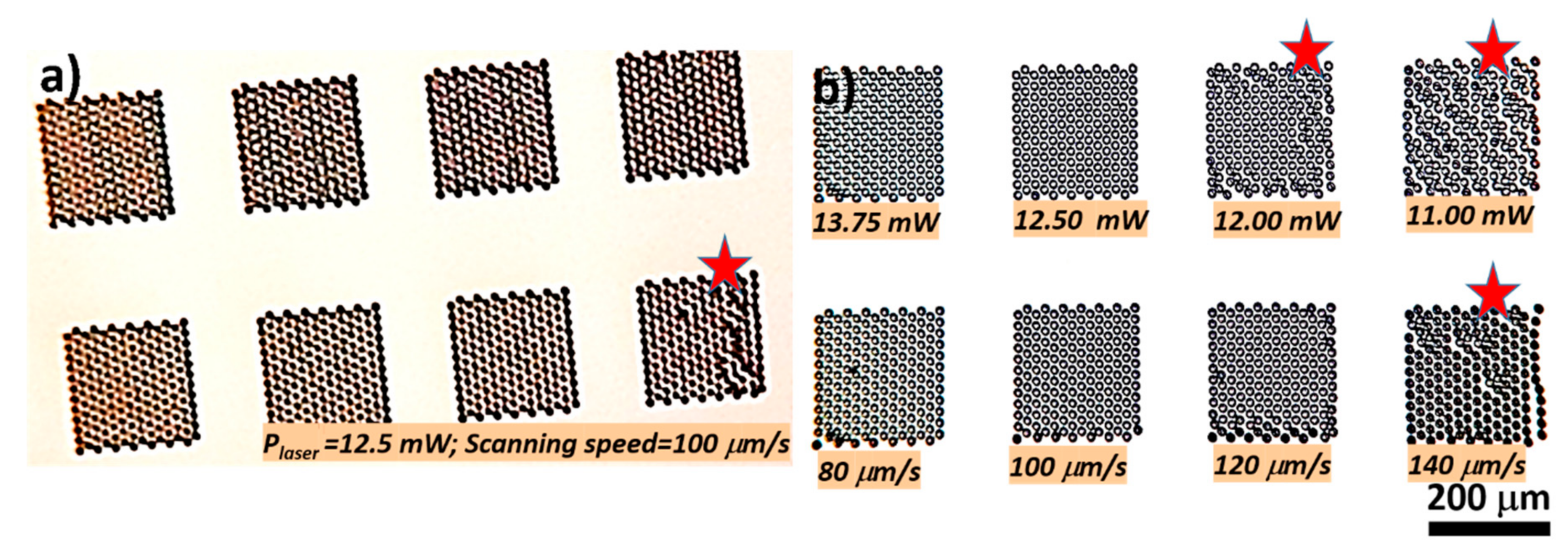

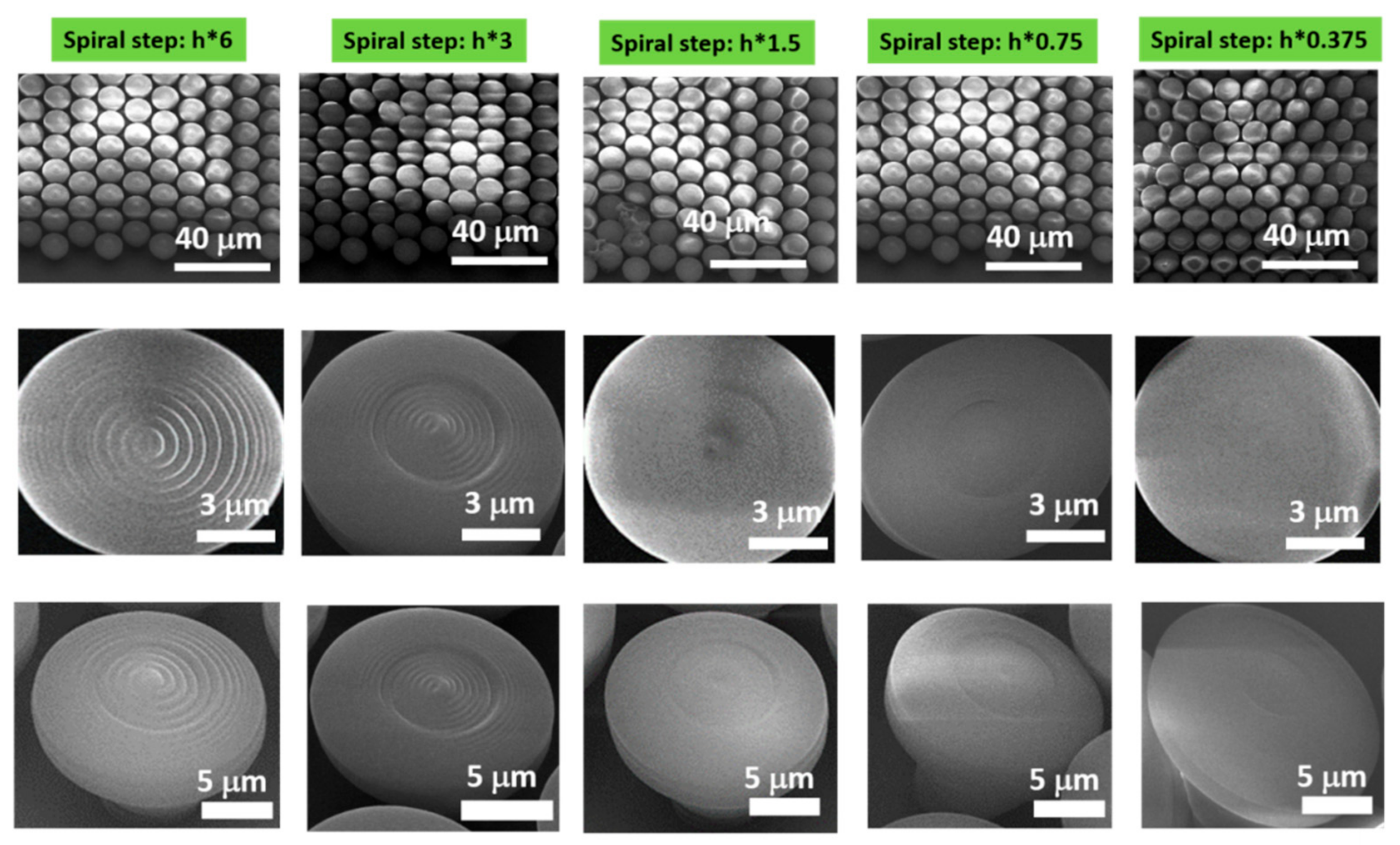
Publisher’s Note: MDPI stays neutral with regard to jurisdictional claims in published maps and institutional affiliations. |
© 2022 by the authors. Licensee MDPI, Basel, Switzerland. This article is an open access article distributed under the terms and conditions of the Creative Commons Attribution (CC BY) license (https://creativecommons.org/licenses/by/4.0/).
Share and Cite
Paun, I.A.; Calin, B.S.; Popescu, R.C.; Tanasa, E.; Moldovan, A. Laser Direct Writing of Dual-Scale 3D Structures for Cell Repelling at High Cellular Density. Int. J. Mol. Sci. 2022, 23, 3247. https://doi.org/10.3390/ijms23063247
Paun IA, Calin BS, Popescu RC, Tanasa E, Moldovan A. Laser Direct Writing of Dual-Scale 3D Structures for Cell Repelling at High Cellular Density. International Journal of Molecular Sciences. 2022; 23(6):3247. https://doi.org/10.3390/ijms23063247
Chicago/Turabian StylePaun, Irina Alexandra, Bogdan Stefanita Calin, Roxana Cristina Popescu, Eugenia Tanasa, and Antoniu Moldovan. 2022. "Laser Direct Writing of Dual-Scale 3D Structures for Cell Repelling at High Cellular Density" International Journal of Molecular Sciences 23, no. 6: 3247. https://doi.org/10.3390/ijms23063247
APA StylePaun, I. A., Calin, B. S., Popescu, R. C., Tanasa, E., & Moldovan, A. (2022). Laser Direct Writing of Dual-Scale 3D Structures for Cell Repelling at High Cellular Density. International Journal of Molecular Sciences, 23(6), 3247. https://doi.org/10.3390/ijms23063247





